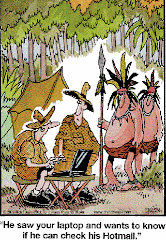There is a convention to intersperse someone else's original message with points of your own when you reply. Consequently, it takes a while to figure out what is original and what is new.
Avoid wasting people's time.
Create a proper response as you would a business letter. Instead of leaving an entire message that you received intact, just make a reference to it. They don't need to read everything they wrote when you respond to them.
Consider carefully what you write; it's a permanent record and can be easily forwarded to others. Never accuse people, call them names, suggest they aren't being smart or criticize their spelling. Assume their intentions are genuine. Avoid sarcasm. Be polite and assertive if necessary (i.e. to spammers) but not vindictive.
Don't attach large files without getting permission from your recipient first.
Write descriptive subject lines. Many busy people will only open messages with captivating subject lines. Think creatively.
If you must forward a message, put your comments at the top.
Learn how to keep an address book to save e-mail addresses, automatically insert them into a new message and maintain groups of contacts.
Use auto-responders to offer frequently requested information. These e-mail bots will automatically respond to the sender with a prewritten message. They are often used for brochures, price lists, directions, etc.
Delete all unnecessary mail. Old messages congest servers. Delete old, duplicate or reply version copies and free up space for new incoming mail.
Delete messages with attachments after you have saved them to your hard drive. They take up a lot of space on the server.
When replying to a message, be sure you reply to just the person you want. Be careful not to accidentally reply to an institute wide message.
Be careful with punctuation. A lot of periods can separate thoughts..... but use a lot of exclamation marks and it looks like you're angry!!!!!!!!!! How does a line of question marks look ??????? You might not intend strong emotion, but the other person might think you do
Use the blind carbon copy (bcc) feature for your own mailing lists. You can send out periodic announcements to a list of people. By using the bcc feature, recipients won't be able to copy other people's names and addresses.
Do not forward personal e-mail to a discussion group without the author's permission.
Don't attach files when posting to discussion groups. Refer participants to a web site where they can find the information.
Don't send entire web pages to a discussion group, just post the web address.
Don't blatantly promote your business by posting an advertisement to a discussion group, unless it is clearly an accepted use and you have cleared it with the moderator (if there is one) first. Otherwise, you are "spamming." Offering information of value, rather than simply inviting people to your web site.
Avoid 'cyber-speak'! Not everyone is familiar with the cute acronyms used in E-mail correspondence, such as IMHO (in my humble opinion) or FWIW (for what it's worth). Performing a mental translation each time slows down the reader. Don't make reading difficult for them.

























































































































